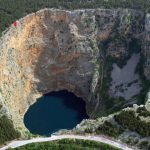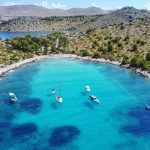February 26, 2020 – Images of a burning effigy of a gay couple during the Imotski Carnival went all around the world, shocking many. But this is only one part of the story. A look at conservative and liberal Adriatic coastal diversity.
What is Croatian cuisine? How do you define it?
The truth is that there is no national cuisine as such, more a group of (outstanding) regional cuisines, which have little in common apart from their excellence. The heavy meat dishes and river fish from Slavonia for example, differ greatly from the freshly grilled fish soaking in olive oil and accompanied by fresh blitva in Dalmatia.
And so too with the people who make up this beautiful land. Hard-working Slavonians and laid-back Dalmatians, more sophisticated types in the capital Zagreb to the more liberal, working-class cities such as Rijeka, while Istria has half an eye on Italy in terms of cuisine and culture. This diversity is one of the things I love most about living here, but it also makes it extremely difficult to tar Croatians with the same brush. For the regions are VERY different, at least in my opinion. Two very public events recently perhaps help to highlight that diversity. The first did not get as much international publicity as it perhaps deserved, while the second was a much smaller affair and went all over the globe.
I thought the opening day and night of Rijeka 2020, European Capital of Culture, was absolutely fantastic. There was an energy in Rijeka I had not come across during my time here, and I partied until 6am and ended up sleeping in the car. My experience (perhaps without finishing in the car) was mirrored by other foreigners I met along the way. You can read my comprehensive account here.
Had I been oblivious to the Croatian media, I might have concluded that everyone enjoyed a fantastic experience, but this is Croatia… The fact that the event was boycotted (there is no other word, in my opinion) by the then Croatian President, herself a Rijeka native, with other notable absentees including the Prime Minister and Speaker of the House, was an early indication of the politics involved.
Red Rijeka certainly did not hold back in celebrating its socialist history, and the showcasing of the Yugoslav flag in a prominent exhibition with no mention of the victims of the Tito regime caused outrage in the right-wing media in Croatia. The event and content was severely attacked on television and online portals and was the subject of lively debate for days. Red Rijeka is obviously comfortable with its direction, and Mayor Obersnel appeared dressed at Tito’s wife Jovanka at this week’s carnival, which did little to endear him to the right-wing sections of the country.
Meanwhile, in a little town in inland Dalmatia, another carnival story emerged, as the Imotski carnival burned an effigy of a gay couple carrying a child doll in the image of SDP MP Nenad Stazic, including the Yugoslav red star on his forehead. Stazic had supported the first gay foster couple recently. While the traditional carnival has always included the burning of a figure as satire, many thought the Imotski organisers had gone too far. National media condemnation was accompanied by international, with one portal comparing it to a 1935 carnival in Germany where the Jews were the subject of ridicule.
And so began another keyboard warrior battle between the two main sides of Croatian society. The liberals condemning the act, the conservatives broadly standing their ground and talking about the right of free speech. As an advert for a tourism country, it was appalling, and the many comments included several who said that this event meant that would cross Croatian off the bucket list. Which I can understand, but it got me thinking, especially after that totally different experience in Rijeka, which was as liberal as any Western city I have spent time in.
A little like that non-existent central Croatian cuisine, the regions of Croatia are very different. And Imotski is quite possibly the most entrenched in its ways and thinking in the whole country. How best to illustrate that diversity in a simple format?
I decided to take a look at the regional results on the 2013 national referendum, often referred to as the ‘gay marriage referendum’, when Croatia voted on the simple question – “Do you agree that marriage is matrimony between a man and a woman?”
Around 65% of voters decided that they did, and so the constitution was changed to ban same-sex marriage. But while two thirds may have voted for it on average nationally, the regional votes were VERY diverse, with Imotski one of just two places that voted more than 95% yes. Indeed, the area around Imotski included 5 of the 7 towns which voted more than 90% yes. All the Dalmatian counties from Zadar to Dubrovnik voted 74-77% yes – the traditional conservative heartland of Croatia.
By contrast, further up the coast, the voting was very different. The biggest opponents to the referendum were in Labin in Istria (71%). Rijeka was 59% against, while the Istrian peninsula was 58% against. I think it is fair to say that the likes of Rijeka and Istria are a little more liberal than large parts of Dalmatia. I am not saying that it is a good thing or a bad thing, just a statement of fact.
Having lived in Dalmatia for 13 years, I love the place, and I am also very fond of Imotski on the many times I have visited. But it is VERY conservative, traditional, right-wing and nationalistic. Quite how far to the right a friend found out several years ago on a visit there to a cafe which has since closed and is under new ownership – Caffe-Bar A D O L F.
“We were in a large group, 4-5 families on a road trip to Međugorje via Pisak, Runovići and Imotski… We sat down for coffee and juice and I was intrigued by the name of the bar. My wife said “Oh, no, I’m sure it’s just a coincidence, that would be too crazy.”
“So a few minutes later I go inside to the toilet and, sure enough, “Poglavnikovo pivo” (a reference to Ante Pavelic) and “Hitlerovo vino” proudly displayed on a shelf behind the bar.
“So I did my business in the toilet and we immediately left …”
But you wouldn’t find that in Rijeka or most of the rest of the country.
The Croatian Government put out a statement on the Imotski incident on its official website:
“The tradition of burning the carnival effigy usually consisted of a sort of humorous and mocking criticism of various events in Croatian society. That sort of carnival spirit can remain within the boundaries of satire when it ‘judges’ someone in power like the president, the prime minister, a mayor or some other politician, but by no means those who represent various minorities in Croatian society. That is not traditional, nor entertaining nor in the spirit of Croatian and European values. As such, we condemn that act,” the government said.
“Our approach is that we oppose any form of hate speech and aggression – political, ideological, verbal and physical – just like any other act that offends the feelings of the Croatian people and contributes to divisions in society.”
Croatia is as diverse and complicated as it is beautiful. Perhaps not all parts are for everyone, but there is certainly something for everyone with its Adriatic coastal diversity.










